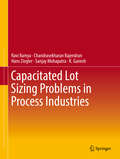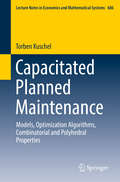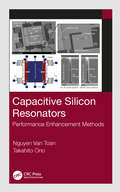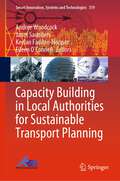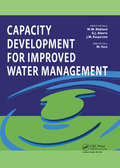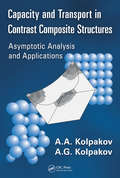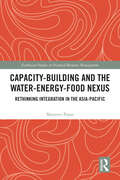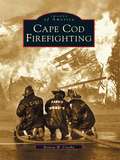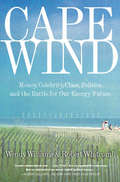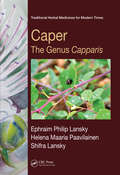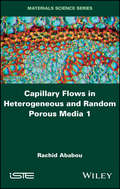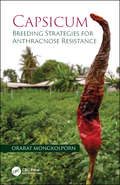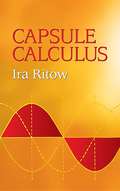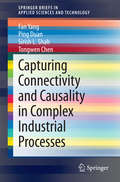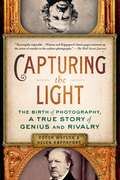- Table View
- List View
Capabilities-Based Planning for Energy Security at Department of Defense Installations
by Henry H. Willis Constantine SamarasDepartment of Defense (DoD) installations rely on the commercial electricity grid for 99 percent of their electricity needs, but the U. S. electricity grid is vulnerable to disruption from natural hazards and actor-induced outages, such as physical or cyber attacks. Using portfolio analysis methods for assessing capability options, this paper presents a framework to evaluate choices among energy security strategies for DoD installations.
Capability Planning and Analysis to Optimize Air Force Intelligence, Surveillance, and Reconnaissance Investments
by National Research Council Division on Engineering and Physical Sciences Committee on Examination of the Air Force Intelligence, Surveillance, and Reconnaissance (ISR) Capability Planning and Analysis (CPA&A) Process Air Force Studies BoardIntelligence, surveillance, and reconnaissance (ISR) capabilities have expanded situation awareness for U.S. forces, provided for more precise combat effects, and enabled better decision making both during conflicts and in peacetime, and reliance on ISR capabilities is expected to increase in the future. ISR capabilities are critical to 3 of the 12 Service Core Functions of the U.S. Air Force: namely, Global Integrated ISR (GIISR) and the ISR components of Cyberspace Superiority and Space Superiority, and contribute to all others. In response to a request from the Air Force for ISR and the Deputy Assistant Secretary of the Air Force for Science, Technology, and Engineering, the National Research Council formed the Committee on Examination of the Air Force Intelligence, Surveillance, and Reconnaissance (ISR) Capability Planning and Analysis (CP&A) Process. In this report, the committee reviews the current approach to the Air Force corporate planning and programming process for ISR capability generation; examines carious analytical methods, processes, and models for large-scale, complex domains like ISR; and identifies the best practices for the Air Force. In Capability Planning and Analysis to Optimize Air Force Intelligence, Surveillance, and Reconnaissance Investments, the current approach is analyzed and the best practices for the Air Force corporate planning and programming processed for ISR are recommended. This report also recommends improvements and changes to existing analytical tools, methods, roles and responsibilities, and organization and management that would be required to ensure the Air Force corporate planning and programming process for ISR is successful in addressing all Joint, National, and Coalition partner's needs.
Capacitated Lot Sizing Problems in Process Industries
by Sanjay Mohapatra K. Ganesh Ravi Ramya Chandrasekharan Rajendran Hans ZieglerThis book examines the Capacitated Lot Sizing Problem (CLSP) in process industries. In almost all process industries, there are situations where products have short/long setup times, and the setup of the product and its subsequent production are carried over, across consecutive periods. The setup of a product is carried over across more than one successive period in the case of products having long setup times. A product having short setup has its setup time less than the capacity of the period in which it is setup. The setup is immediately followed by its production of the product and it may also be carried over, across successive time period(s). Many process industries require production of a product to occur immediately after its setup (without the presence of idle time between the setup and production of the product), and they also require the product to be continuously produced without any interruption. This book considers a single-machine, single-level and multiple-item CLSP problem. This book introduces the Capacitated Lot Sizing Problem with Production Carryover and Setup Crossover across periods (CLSP-PCSC). Mathematical models are proposed which are all encompassing that they can handle continuous manufacturing (as in process industries), and also situations where the setup costs and holding costs are product dependent and time independent/time dependent, with possible backorders, and with other appropriate adaptations. Comprehensive heuristics are proposed based on these mathematical models to solve the CLSP-PCSC. The performance of the proposed models and heuristics are evaluated using problem instances of various sizes. This book also covers mathematical models developed for the Capacitated Lot Sizing Problem with Production Carryover and Setup Crossover across periods, and with Sequence-Dependent Setup Times and Setup Costs (CLSP-SD-PCSC). These models allow the presence of backorders and also address real-life situations present in process industries such as production of a product starting immediately after its setup and its uninterrupted production carryover across periods, along with the presence of short/long setup times. Heuristics proposed for the CLSP-PCSC can be extended to address the CLSP problem with sequence dependent setup costs and setup times. All the models and heuristics proposed in this book address some real-life considerations present in process industries.
Capacitated Planned Maintenance: Models, Optimization Algorithms, Combinatorial and Polyhedral Properties (Lecture Notes in Economics and Mathematical Systems #686)
by Torben KuschelThis book examines the problem of maintenance planning and scheduling in industrial production systems. It presents two practically relevant, deterministic mathematical models: the capacitated planned maintenance problem (CPMP) and the weighted uncapacitated planned maintenance problem (WUPMP). It introduces specific optimization algorithms such as construction heuristics, Lagrangean and tabu search metaheuristics. A problem independent hybrid approach links and alternates between two Lagrangean relaxations. It also analyzes the solvability with respect to the computational complexity of several problem classes, polyhedral properties and lower bounds. Computational studies demonstrate the performance of the heuristics, lower bounds, subgradients obtained from heuristics and the quality of dual information. This unique book includes implementation details and an introduction to the necessary theory making it suitable for upper undergraduate students.
Capacitive Silicon Resonators: Performance Enhancement Methods
by Takahito Ono Nguyen Van ToanMicrofabricated resonators play an essential role in a variety of applications, including mass sensing, timing reference applications, and filtering applications. Many transduction mechanisms including piezoelectric, piezoresistive, and capacitive mechanisms, have been studied to induce and detect the motion of resonators. This book is meant to introduce and suggest several technological approaches together with design considerations for performance enhancement of capacitive silicon resonators, and will be useful for those working in field of micro and nanotechnology. <P><P>Features <li>Introduces and suggests several technological approaches together with design considerations for performance enhancement of capacitive silicon resonators <li>Provides information on the various fabrication technologies and design considerations that can be employed to improve the performance capacitive silicon resonator which is one of the promising options to replace the quartz crystal resonator. <li>Discusses several technological approaches including hermetic packaging based on the LTCC substrate, deep reactive ion etching, neutral beam etching technology, and metal-assisted chemical etching, as well as design considerations for mechanically coupled, selective vibration of high-order mode, movable electrode structures, and piezoresistive heat engines were investigated to achieve small motional resistance, low insertion loss, and high quality factor. <li>Focuses on a capacitive sensing method based on the measurement of the change in capacitance between a sensing electrode and the resonant body. <li>Reviews recent progress in performance enhancement methods for capacitive silicon resonator, which are mainly based on the works of the authors.
Capacitively-Coupled Chopper Amplifiers (Analog Circuits and Signal Processing)
by Johan H. Huijsing Kofi A. A. Makinwa Qinwen FanThis book describes the concept and design of the capacitively-coupled chopper technique, which can be used in precision analog amplifiers. Readers will learn to design power-efficient amplifiers employing this technique, which can be powered by regular low supply voltage such as 2V and possibly having a +/-100V input common-mode voltage input. The authors provide both basic design concepts and detailed design examples, which cover the area of both operational and instrumentation amplifiers for multiple applications, particularly in power management and biomedical circuit designs.
Capacity Building for the Planning, Assessment and Systematic Observations of Forests: With Special Reference to Tropical Countries (Environmental Science and Engineering)
by Karan Deo SinghThis book is intended to support the forestry institutions in the tropical countries in the planning, assessment and systematic observation of forests required to fulfill their obligations as laid in international conventions such as the CBD and UNFCCC. Following the Rio Conference, a number of countries, donors and international organizations have implemented capacity-building projects with varying degrees of success. One main reason for the varying success rates seems to lie in the design of technical assistance programs, which have been formulated on the traditional lines of mainly generating forest resources information or transferring technology; whereas Agenda 21 requires fundamental changes in countries' institutions and approaches to planning and implementing the conservation and sustainable development of forests through a process of continuing research and analysis. The book is intended to serve the basic needs of national planning strategies and international and donor support.
Capacity Building in Local Authorities for Sustainable Transport Planning (Smart Innovation, Systems and Technologies #319)
by Andree Woodcock Janet Saunders Keelan Fadden-Hopper Eileen O’ConnellThis book is conceptualized as being of interest to researchers in the field of sustainable transport, and also those who are working in the field. In the first case it will provide a reference on the state of the art of sustainable transport, and will also include insights into an EU project, how to go about delivering impact, how such projects effect local authorities, etc. Sustainable transport is an extreme growth area; it is highly innovative, with multi-million-pound investments transforming cities. The book will help and encourage resource poor small to medium local authorities catch up and meet their sustainability targets.
Capacity Development for Improved Water Management
by M.W. Blokland, G.J. Alaerts, J.M. Kaspersma and M. HareThis collection of papers explains how knowledge and capacity development can contribute to improved, effective water management with a digest of lessons learned in the areas of development of tools and techniques, field applications and evaluation. The authors are prominent practitioners, capacity builders and academics within the water and capacity development sectors.Capacity Development for Improved Water Management starts with an introduction and overview of progress and challenges in knowledge and capacity development in the water sector. The next part presents tools and techniques that are being used in knowledge and capacity development in response to the prevailing challenges in the water sector, and a review of experience with capacity change in other sectors. In the third part a number of cases are presented that cover knowledge and capacity development experiences in the water resources and water services sectors. This part also presents experiences on water education for children and on developing gender equity. The fourth part provides experiences with the monitoring and evaluation of knowledge and capacity building.
Capacity and Transport in Contrast Composite Structures: Asymptotic Analysis and Applications
by A. A. Kolpakov A. G. KolpakovIs it possible to apply a network model to composites with conical inclusions?How does the energy pass through contrast composites? Devoted to the analysis of transport problems for systems of densely packed, high-contrast composite materials, Capacity and Transport in Contrast Composite Structures: Asymptotic Analysis and Applications an
Capacity-Building and the Water-Energy-Food Nexus: Rethinking Integration in the Asia-Pacific (Earthscan Studies in Natural Resource Management)
by Maureen PapasCritically analysing methodologies and objectives of capacity building and the practical linkages required to achieve the Sustainable Development Goals, this book looks at whether nexus thinking offers a systematic approach to combat global environmental problems and facilitate enhanced sustainable development. Building effective and sustainable mechanisms to tackle environmental problems requires in-depth understanding of relationships between natural resources, going beyond conventional policy and siloed decision making. The water energy food nexus has been promoted as a conceptual framework and management tool to facilitate integrated planning and practical linkages to support sustainable development. The author opens this book with an overview of capacity building and reviews the significance of the water energy food nexus, bringing in links to the 2030 Agenda. Climate change is highlighted as a key consideration in any conversation about natural resource use and case studies from Japan, India and China are utilised to show that whist long-term sustainable development practices are being implemented the environmental challenges across the region raise concerns about institutional capacity, economic sustainability and future of the region. Finally, through the lens of capacity building, the book suggests that whilst the water energy food nexus may provide a new approach to sustainable development, it will not be enough to achieve long-term sustainability or extend to the lives of those most affected. The book will be interest to scholars and students within the water, energy and agriculture sectors, sustainability governance and sustainable development. It will also be a valuable resource to those working in governmental organisations and NGOs involved in capacity building and development.
Cape Cod Firefighting (Images of America)
by Britton W. CrosbyFrom the founding of its first fire department in Provincetown in 1836, Cape Cod has had an exciting and unique firefighting history-as told in Cape Cod Firefighting. Rare and recently discovered photographs depict some of the area's largest fires, as well as its many innovations, from Provincetown's first Hunneman hand pumper, known as the "George Washington," to the brush breakers uniquely designed to respond to the Cape's devastating forest fires. Cape Cod fire departments also developed rescue squads that eventually evolved into the first emergency medical service system in Massachusetts to use paramedics. The images in Cape Cod Firefighting offer a tribute to the people and events that have shaped Cape Cod's fire rescue service.
Cape Wind: Money, Celebrity, Class, Politics, and the Battle for Our Energy Future on Nantucket Sound
by Robert WhitcombWhen Jim Gordon set out to build a wind farm off the coast of Cape Cod, he knew some people might object. <P><P>But there was a lot of merit in creating a privately funded, clean energy source for energy-starved New England, and he felt sure most people would recognize it eventually. Instead, all Hell broke loose. Gordon had unwittingly challenged the privileges of some of America's richest and most politically connected people, and they would fight him tooth and nail, no matter what it cost, and even when it made no sense. Cape Wind is a rollicking tale of democracy in action and plutocracy in the raw as played out among colorful and glamorous characters on one of our country's most historic and renowned pieces of coastline. As steeped in American history and local color as The Prince of Providence; as biting, revealing and fun as Philistines at the Hedgerow, it is also a cautionary tale about how money can hijack democracy while America lags behind the rest of the developed world in adopting clean energy.
Caper: The Genus Capparis (Traditional Herbal Medicines for Modern Times)
by Shifra Lansky Helena Maaria Paavilainen Ephraim Philip LanskyCaper: The Genus Capparis presents a pharmacognostic and ethnopharmacological exploration of the genus Capparis, emphasizing its medicinal potential. There is a long history of safe usage of Capparis parts both in diet and as plant drugs throughout the world, and the details of this usage are summarized in 39 tables covering numerous Capparis speci
Capillary Flows in Heterogeneous and Random Porous Media
by Rachid AbabouCapillary phenomena occur in both natural and human-made systems, from equilibria in the presence of solids (grains, walls, metal wires) to multiphase flows in heterogeneous and fractured porous media. This book, composed of two volumes, develops fluid mechanics approaches for two immiscible fluids (water/air or water/oil) in the presence of solids (tubes, joints, grains, porous media). Their hydrodynamics are typically dominated by capillarity and viscous dissipation. This first volume presents the basic concepts and investigates two-phase equilibria, before analyzing two-phase hydrodynamics in discrete and/or statistical systems (tubular pores, planar joints). It then studies flows in heterogeneous and stratified porous media, such as soils and rocks, based on Darcy’s law. This analysis includes unsaturated flow (Richards equation) and two-phase flow (Muskat equations). Overall, the two volumes contain basic physical concepts, theoretical analyses, field investigations and statistical and numerical approaches to capillary-driven equilibria and flows in heterogeneous systems
Capillary Flows with Forming Interfaces
by Yulii D. ShikhmurzaevCapillary Flows with Forming Interfaces explores numerous theoretical problems that arise in the mathematical description of capillary flows. It focuses on developing a unified approach to a variety of seemingly very different capillary flows of practical importance where classical fluid mechanics leads to nonphysical results.The book begin
Capillary Gas Chromotography in Food Control and Research
by R. WittkowskiThis book offers a comprehensive survey on the possibilities, applications, and new developments of capillary gas chromatography for the complete range of examinations of food and raw material. It is intended for food scientists/chemists, food technologists, and nutritionists.
Capital Mysteries #1: Who Cloned the President?
by Ron Roy Liza WoodruffKC Corcoran always watches the news. So it's no surprise that she notices right away when the president starts acting funny on TV. He's stiff and awkward. He's even signing papers with the wrong hand. There's only one explanation-the president has been cloned! And it's up to KC and her best friend, Marshall, to save him.From the Trade Paperback edition.
Capsicum: Breeding Strategies for Anthracnose Resistance
by Orarat MongkolpornCapsicum, more commonly as chili or chili pepper, is an important global vegetable and spice crop. Anthracnose disease, caused by a complex of Colletotrichum species, is the major biotic stress limiting chili production in tropical and subtropical countries. Anthracnose disease mainly manifests itself as a post-harvest disease, resulting in large necrotic lesions on the fruit. This disease is mainly controlled by the application of a "cocktail" of fungicides as commercial resistant cultivars are not available. In recent years, insights into the complexity of the pathogen and the genomics of the host have been accomplished using cutting-edge molecular technologies. The author has been at the forefront of this technology revolution in Capsicum breeding through her research to understand the host and pathogen which has led to the development of new anthracnose resistant genotypes. Capsicum: Breeding Strategies for Anthracnose Resistance is structured based on a review of the origin and evolution of Capsicum, Capsicum genetic diversity and germplasm resources, the latest research in the biology and taxonomy of Colletotrichum pathogens of Capsicum, and the classic and molecular breeding for resistance in Capsicum to the suite of Colletotrichum pathogens that infect Capsicum globally. This book brings together knowledge on both the pathogen and the host, which is often overlooked when reviewing the breeding and genetics of a crop plant. It informs the facts behind breeding for resistance from both the host and pathogen perspectives.
Capsule Calculus
by Ira RitowThis brief introductory text presents the basic principles of calculus from the engineering viewpoint. Excellent either as a refresher or as an introductory course, it focuses on developing familiarity with the basic principles rather than presenting detailed proofs.Topics include differential calculus, in terms of differentiation and elementary differential equations; integral calculus, in simple and multiple integration forms; time calculus; equations of motion and their solution; complex variables; complex algebra; complex functions; complex and operational calculus; and simple and inverse transformations. Advanced subjects comprise integrations and differentiation techniques, in addition to a more sophisticated variety of differential equations than those previously discussed.It is assumed that the reader possesses an acquaintance with algebra and trigonometry as well as some familiarity with graphs. Additional background material is presented as needed.
Captain Arsenio
by Pablo BernasconiCaptain Arsenio was a curious man who liked, more than anything, to tinker and explore. One day in 1782, he decided that he would put his unusual skills to work in a most ambitious way: he would build a flying machine. Despite a hodgepodge of materials (and a total unawareness of the laws of physics), Captain Arsenio aimed to get his feet off the ground and his head in the clouds-temporarily, at least. But would any of his crazy inventions ever achieve flight? In this hilarious fictional account, Pablo Bernasconi imagines a legend in the making-a retired cheesemaker and scuba diver turned inventor who sets off to fly with the birds, in spite of himself.
Captivate, Activate, and Invigorate the Student Brain in Science and Math, Grades 6-12
by John T. Almarode Ann M. MillerBanish boredom once and for all! If your STEM lessons are falling on disinterested ears, mix things up with engaging, brain-based science and math strategies that captivate students’ attention, activate prior knowledge, and invigorate interest. Blending current research on the student brain with practical methods for teaching science and math, Almarode and Miller identify six essential “ingredients” in a recipe for student success. You’ll discover: A customizable framework you can use right away Classroom-ready, content-specific attention grabbers Overt and covert strategies to boost behavioral, emotional, and cognitive engagement Techniques for making relevant connections that maximize retention
Capturing Change in Science, Technology, and Innovation: Improving Indicators to Inform Policy
by Robert E. LitanSince the 1950s, under congressional mandate, the U. S. National Science Foundation (NSF) - through its National Center for Science and Engineering Statistics (NCSES) and predecessor agencies - has produced regularly updated measures of research and development expenditures, employment and training in science and engineering, and other indicators of the state of U. S. science and technology. A more recent focus has been on measuring innovation in the corporate sector. NCSES collects its own data on science, technology, and innovation (STI) activities and also incorporates data from other agencies to produce indicators that are used for monitoring purposes - including comparisons among sectors, regions, and with other countries - and for identifying trends that may require policy attention and generate research needs. NCSES also provides extensive tabulations and microdata files for in-depth analysis. "Capturing Change in Science, Technology, and Innovation" assesses and provides recommendations regarding the need for revised, refocused, and newly developed indicators of STI activities that would enable NCSES to respond to changing policy concerns. This report also identifies and assesses both existing and potential data resources and tools that NCSES could exploit to further develop its indicators program. Finally, the report considers strategic pathways for NCSES to move forward with an improved STI indicators program. The recommendations offered in "Capturing Change in Science, Technology, and Innovation" are intended to serve as the basis for a strategic program of work that will enhance NCSES's ability to produce indicators that capture change in science, technology, and innovation to inform policy and optimally meet the needs of its user community.
Capturing Connectivity and Causality in Complex Industrial Processes (SpringerBriefs in Applied Sciences and Technology)
by Fan Yang Ping Duan Sirish L. Shah Tongwen ChenThis brief reviews concepts of inter-relationship in modern industrial processes, biological and social systems. Specifically ideas of connectivity and causality within and between elements of a complex system are treated; these ideas are of great importance in analysing and influencing mechanisms, structural properties and their dynamic behaviour, especially for fault diagnosis and hazard analysis. Fault detection and isolation for industrial processes being concerned with root causes and fault propagation, the brief shows that, process connectivity and causality information can be captured in two ways: · from process knowledge: structural modeling based on first-principles structural models can be merged with adjacency/reachability matrices or topology models obtained from process flow-sheets described in standard formats; and · from process data: cross-correlation analysis, Granger causality and its extensions, frequency domain methods, information-theoretical methods, and Bayesian networks can be used to identify pair-wise relationships and network topology. These methods rely on the notion of information fusion whereby process operating data is combined with qualitative process knowledge, to give a holistic picture of the system.
Capturing The Light: The Birth Of Photography, A True Story Of Genius And Rivalry
by Helen Rappaport Roger WatsonAn intimate look at the journeys of two men―a gentleman scientist and a visionary artist―as they struggled to capture the world around them, and in the process invented modern photography During the 1830s, in an atmosphere of intense scientific enquiry fostered by the industrial revolution, two quite different men―one in France, one in England―developed their own dramatically different photographic processes in total ignorance of each other's work. These two lone geniuses―Henry Fox Talbot in the seclusion of his English country estate at Lacock Abbey and Louis Daguerre in the heart of post-revolutionary Paris―through diligence, disappointment and sheer hard work overcame extraordinary odds to achieve the one thing man had for centuries been trying to do―to solve the ancient puzzle of how to capture the light and in so doing make nature 'paint its own portrait'. With the creation of their two radically different processes―the Daguerreotype and the Talbotype―these two giants of early photography changed the world and how we see it. Drawing on a wide range of original, contemporary sources and featuring plates in colour, sepia and black and white, many of them rare or previously unseen, Capturing the Light by Roger Watson and Helen Rappaport charts an extraordinary tale of genius, rivalry and human resourcefulness in the quest to produce the world's first photograph.


